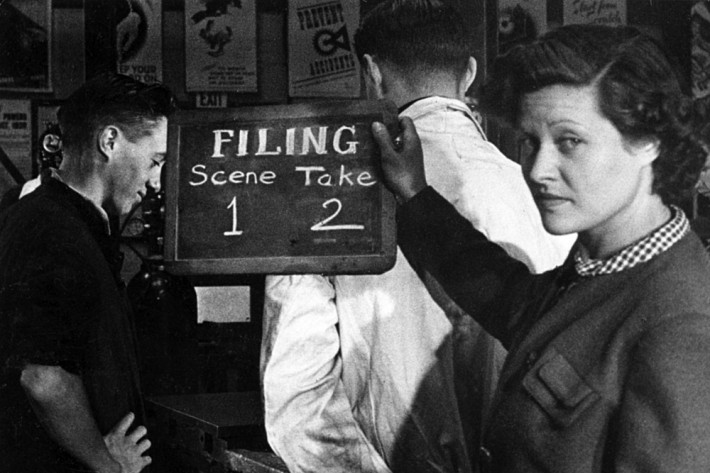Women and Media Histories
Dr Melanie Bell-Williams provides an overview of a new research project on the history of women’s contribution to British film and television production.
 About the author: Dr Melanie Bell-Williams is Senior Lecturer in Film at Newcastle University. Her primary research interest is the relationship between gender and film, with an emphasis on production, representation and consumption. Within the context of British film and cinema Dr Bell-Williams interested in women’s involvement in the production process and questions of agency, gender and production cultures and textual femininities/screen representations of women. Her publications include: Femininity in the Frame: Women and 1950s British Popular Cinema (I.B. Tauris, 2010); Bell M, Williams M, eds. British Women’s Cinema (Routledge, 2009); Julie Christie: Cinema, Stardom and Creative Control (BFI Palgrave Macmillan, 2015, forthcoming).
About the author: Dr Melanie Bell-Williams is Senior Lecturer in Film at Newcastle University. Her primary research interest is the relationship between gender and film, with an emphasis on production, representation and consumption. Within the context of British film and cinema Dr Bell-Williams interested in women’s involvement in the production process and questions of agency, gender and production cultures and textual femininities/screen representations of women. Her publications include: Femininity in the Frame: Women and 1950s British Popular Cinema (I.B. Tauris, 2010); Bell M, Williams M, eds. British Women’s Cinema (Routledge, 2009); Julie Christie: Cinema, Stardom and Creative Control (BFI Palgrave Macmillan, 2015, forthcoming).
This three and a half-year AHRC-funded research project is investigating the contribution women have made to film and television production in Britain. It focuses on the period between 1933 and 1989, a time of considerable social change for women and substantial institutional change for the industries. The project started in January 2014. The research team brings together expertise in film history (Dr Melanie Bell) and oral history interviewing (Sue Bradley) at Newcastle University with television (Dr Vicky Ball) and union history (Frances Galt) at De Montfort University.
Thousands of women have contributed to film and television production in Britain. Those in the high-profile roles of director and producer are relatively well known (Muriel Box, Verity Lambert) but the majority of women have been employed in ‘below-the-line’ roles: hairdressers, continuity ‘girls’, production assistants, negative cutters. These ‘auxiliary’ roles, described by Sally Potter as ‘invisible labour’, are notoriously difficult to research and as a result the history of these women has barely been studied. Much of their work has been further undervalued by academic scholarship that has privileged auteur-directors, and its study hampered by scarce archival sources. This ambitious new project draws on trade union records and oral history testimony to investigate the role women played in shaping the output of these two major creative industries. From 1933 to 1989 film and commercial TV operated as a closed shop and BBC employment was similarly regulated. By tracing women’s contribution through union membership data this project will provide empirical evidence about the number of women who worked in the industries, their roles and their movement between film and television. This data will be supplemented by oral history interviews with women, which explore their working lives. In bringing these two approaches together this project will unlock previously hidden evidence about women’s work – its diversity and historical variability – and develop new ways of conceptualising and historicising the film and television industries through the experiences of below-the-line workers. This will have a wider impact on both the study of film and television and our understanding of the role of women in twentieth-century creative arts/industries.
The focus of this research is timely. The UK has the largest creative sector within the European Union and its industries are major employers. Recent reports however highlight the small number of women currently occupying senior roles in film and television, and a high attrition rate among the female workforce. Employment pathways, traditions and cultures develop over time. Knowing more about what these were like in the past will help us to understand their legacies and their impact on women working in film and television today. The project team are working in partnership with BECTU, the Broadcasting, Entertainment, Cinematograph and Theatre Union, and the British Universities Film & Video Council (BUFVC) and its Head of Research, Linda Kaye. Through this partnership the project will deliver one of its major outputs; a database and contextual website comprising union membership materials (approximately 67,000 records) and oral history interviews with women. This will be published on the BUFVC’s website and will be available to the public and scholars for future research.

Kay Mander filming HOW TO FILE (1941) from the Panamint DVD release, ONE CONTINUOUS TAKE: THE KAY MANDER STORY (image courtesy of Panamint).
 Learning on Screen
Learning on Screen